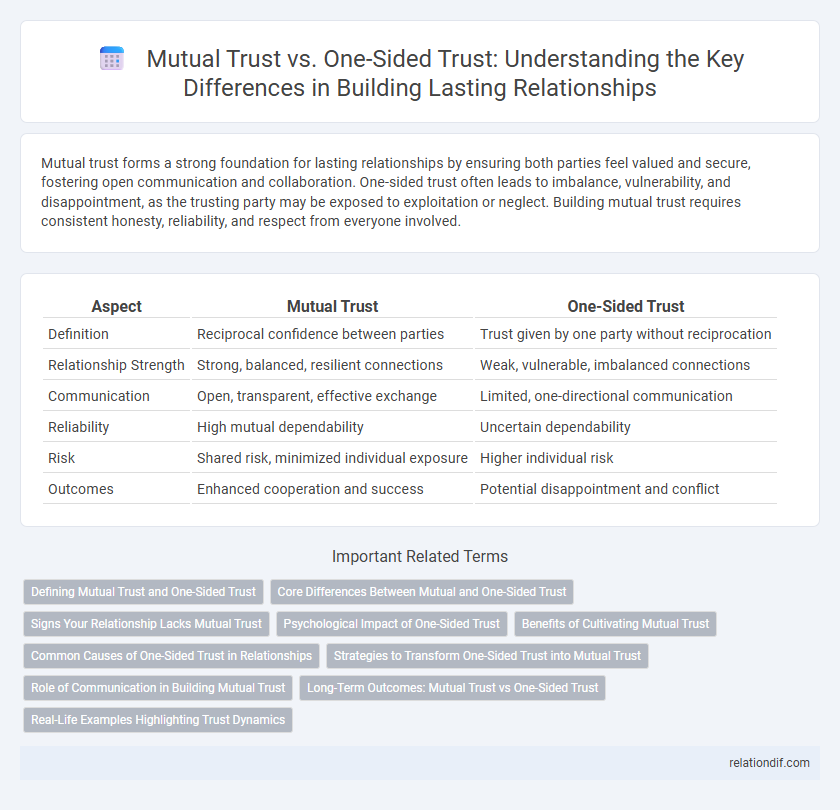Mutual trust forms a strong foundation for lasting relationships by ensuring both parties feel valued and secure, fostering open communication and collaboration. One-sided trust often leads to imbalance, vulnerability, and disappointment, as the trusting party may be exposed to exploitation or neglect. Building mutual trust requires consistent honesty, reliability, and respect from everyone involved.
Table of Comparison
| Aspect | Mutual Trust | One-Sided Trust |
|---|---|---|
| Definition | Reciprocal confidence between parties | Trust given by one party without reciprocation |
| Relationship Strength | Strong, balanced, resilient connections | Weak, vulnerable, imbalanced connections |
| Communication | Open, transparent, effective exchange | Limited, one-directional communication |
| Reliability | High mutual dependability | Uncertain dependability |
| Risk | Shared risk, minimized individual exposure | Higher individual risk |
| Outcomes | Enhanced cooperation and success | Potential disappointment and conflict |
Defining Mutual Trust and One-Sided Trust
Mutual trust occurs when both parties in a relationship consistently demonstrate reliability, honesty, and openness, establishing a balanced foundation of confidence and cooperation. One-sided trust happens when only one party places faith in the other without reciprocal assurance, often leading to vulnerability and potential imbalance. Defining these concepts highlights the importance of shared responsibility in building sustainable and effective interpersonal or organizational relationships.
Core Differences Between Mutual and One-Sided Trust
Mutual trust involves reciprocal confidence where both parties consistently demonstrate reliability, honesty, and transparency, fostering a balanced relationship foundation. One-sided trust occurs when only one individual invests in the reliability and integrity of the other, often leading to vulnerability and imbalance. Core differences include reciprocity, emotional security, and sustainable collaboration, with mutual trust promoting equal commitment while one-sided trust risks distrust and dependency.
Signs Your Relationship Lacks Mutual Trust
A relationship lacking mutual trust often exhibits one partner consistently doubting the other's intentions or hiding important information. Frequent accusations, secrecy, and reluctance to share feelings indicate a significant imbalance where trust is only one-sided. Signs such as avoiding accountability and persistent insecurity highlight the absence of reciprocal faith crucial for a healthy relationship.
Psychological Impact of One-Sided Trust
One-sided trust often leads to feelings of vulnerability and emotional imbalance, as the trustor invests confidence without reciprocal assurance. This dynamic can foster anxiety, mistrust, and decreased self-esteem, impacting mental health negatively. In contrast, mutual trust promotes psychological safety and strengthens interpersonal bonds through balanced emotional investment.
Benefits of Cultivating Mutual Trust
Cultivating mutual trust enhances collaboration and communication by creating an environment where all parties feel respected and valued. It reduces misunderstandings and conflicts, fostering long-term relationships built on reliability and transparency. Organizations with strong mutual trust report higher employee engagement, increased productivity, and improved overall performance.
Common Causes of One-Sided Trust in Relationships
One-sided trust in relationships often stems from imbalanced communication and unmet expectations, where one partner consistently invests emotionally while the other remains detached. Power imbalances and past betrayals contribute significantly to creating an environment where trust is not reciprocated equally. Lack of transparency and inconsistent behavior further reinforce one-sided trust, undermining relationship stability and emotional security.
Strategies to Transform One-Sided Trust into Mutual Trust
Building mutual trust from one-sided trust requires consistent transparency, active listening, and demonstrated reliability over time. Implementing clear communication channels and encouraging vulnerability fosters reciprocal confidence between parties. Establishing shared goals and accountability mechanisms reinforces commitment, transforming unilateral trust into a resilient, balanced relationship.
Role of Communication in Building Mutual Trust
Effective communication fosters mutual trust by ensuring transparency, active listening, and consistent feedback, which helps align expectations and resolve misunderstandings. Open dialogue encourages vulnerability, allowing both parties to share concerns and build emotional safety. This reciprocal exchange strengthens relationships, whereas one-sided trust lacks such interactive engagement and often leads to imbalance and skepticism.
Long-Term Outcomes: Mutual Trust vs One-Sided Trust
Mutual trust fosters resilient relationships with sustained cooperation and shared success, whereas one-sided trust often leads to vulnerability and potential exploitation, undermining long-term stability. Studies indicate that organizations emphasizing mutual trust exhibit higher employee retention and increased innovation over time. Conversely, one-sided trust environments correlate with elevated conflict rates and diminished overall performance in the long run.
Real-Life Examples Highlighting Trust Dynamics
Mutual trust fosters stronger collaboration in teams, as seen in successful partnerships like Apple's co-founders Steve Jobs and Steve Wozniak, where reciprocal confidence drove innovation and growth. One-sided trust often leads to imbalance and vulnerability, exemplified by cases such as financial scams where victims place blind trust in unverified entities leading to significant losses. Real-life dynamics emphasize that balanced, mutual trust builds resilience and sustainable relationships, while one-sided trust risks exploitation and breakdown.
Mutual trust vs one-sided trust Infographic

 relationdif.com
relationdif.com